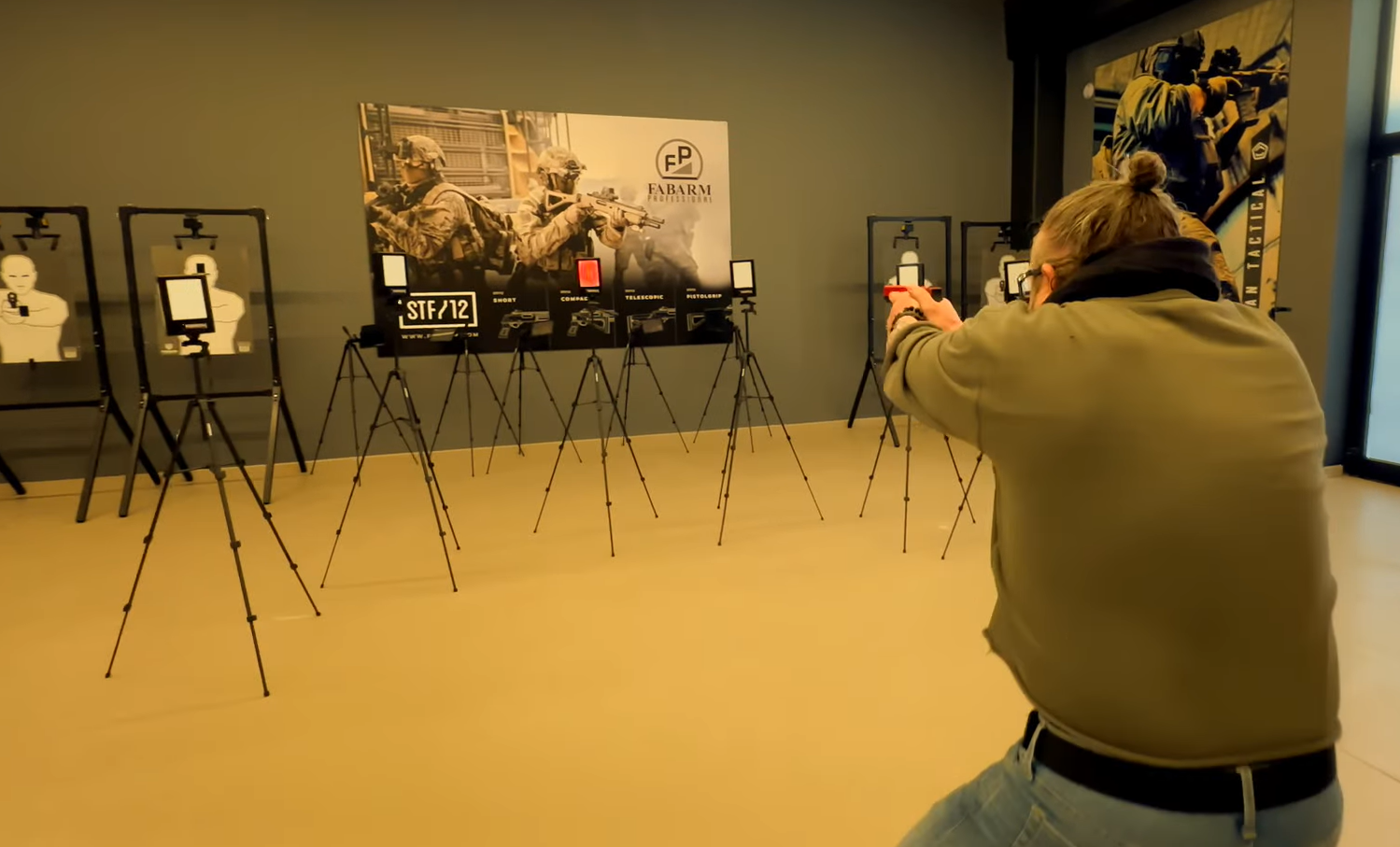THE 3 SPEEDS IN THE DEFENSIVE USE OF THE FIREARM
What many, too many, in this industry have not yet understood is the problem of the “false condition” that is generated in training with firearms and which concerns anyone who carries a firearm for work or defense or anyone who can only think to use a firearm for home defense as a last resort. In fact, each of these categories of subjects trains in a shooting range and I have already described the problem of “redundancy of the environments” in detail in other articles.
Today, however, I want to address the problem relating to another fundamental aspect: the interpretation and use we give to the data we obtain when we measure the speed of a shooter.
In the meantime, let’s start by understanding what type of parameters are used on a global level to analyze a subject’s shooting skills especially in terms of speed.
In 98% of cases the parameters used are mainly 2: TIME and ACCURACY, this applies to any type of test/exercise/protocol whether L.E., MIL and civilians in which a candidate’s abilities must be assessed and it also works like this in sport competitions.
TIME is measured through a phono chronometer (timer) and ACCURACY is measured through terminal ballistics on the target (Holes).
We use TIME to measure a shooter’s speed and we use ACCURACY to measure shooting technique, consistency and effectiveness.
Up to this point everything would seem perfectly correct and sensible and in part it is, but it is in the reading and interpretation of the data we obtain where the problem arises. From the data obtained using this two-factor evaluation criterion, technical standards are set and this is where the “False Condition” is generated. When those standards are absorbed by those involved in training (Trainers/Instructors) and used as an absolute reference, the “false condition” spreads like a virus becoming a dangerous and widespread illusion.
In order to better understand the concept of speed and the type of speed we are referring to; we must analyze the conditions in which the tests are carried out and the parameters measured.
EXAMPLE
If we set a target at 8 yds and asked a shooter to carry out 10 timed extractions and he performed each of the 10 draws in a sub-second and with all hits in Alpha zone, we would consider the shooter to be fast and accurate and therefore with solid and high level technical skills.
As mentioned before, we would therefore use the timer data to define the speed, resulting from the reception of the starting auditory stimulus (beep), so we would define that as reactive speed which, combined with the data coming from the Target (accuracy) would become “Reactive Capacity”.
But is it really like that?
To answer this question we must first analyze the conditions under which the data is obtained and extrapolated.
GENERAL STANDARD CONDITION
Tests/exercises to evaluate a subject’s shooting with a firearm
Whatever the type of exercise to be carried out with the firearm, these conditions normally always exist:
– The execution of the Drill is pre-known and almost always already applied N times.
– All targets are pre-known
– All targets are extremely easy to discriminate against.
– The reactive stimulus is only one, always the same, it is auditory (beeeeep), pre-known, long, easy to discriminate and already discriminated thousands of times previously, discriminated in an environment without acoustic pollution from other stimuli.
– Awareness of the imminence of the action (Shooter are you ready)
-The shooter moves first and is the only one to move so he does not react and does not have to adapt to actions coming from someone else
– No risk of collateral damage from missing
– Optimal light conditions (generally)
– Starting in an upright position (the easiest and quickest)
Having analyzed the conditions of execution of the Tests/Exercises, let’s see what science tells us about it. Science tells us that we interact with the environment 83% through sight, which is therefore our dominant sense, and only 11% through hearing. Not only that, it also tells us that 98% of decision-making processes are mainly based on visual stimuli. This means that when we measure and evaluate the technical skills relating to shooting with firearms of a subject, analyzing data that come from only two parameters that we consider absolute, we do so unaware of the fact that one of the two (therefore 50% of the criterion of evaluation) affects only 11% in reality.
This means that we carry out tests/exercises/protocols with conditions that are not only optimal and extremely simplified but absolutely far from the real ones and we do it inside a shooting range which is a totally different environment from the real context.
THE THREE SPEEDS
Mechanical Speed:
Mechanical speed is the speed with which we are physically able to carry out actions/gestures/movements or sequences of these in each period of time.
Mechanical speed is mainly built on the repetition of the same gesture/movement or the same sequence thousands and thousands of times. Another aspect that affects Mechanical Speed is for sure the TECHNIQUE.
However, since each human being is different from the other, there are N variables in each of us that influence the number of useful repetitions and the development of speed and it would be absolutely empirical and approximate to think of being able to generate a homogeneous standard.
Mechanical Speed is therefore what is exactly measured through the tests we are talking about and is what is mainly developed on the shooting range and in DRY FIRE through repetitions.
Scan Speed:
This is an absolutely little-known speed and therefore represents a skill that is very little developed in training, but which is instead absolutely strategic and essential in real application.
This is the ability of our eyes to scan the environment quickly and in detail. This speed is based partly on some of the visual abilities, partly on the capacity of peripheral vision and the perception of the FOV (Field of View), elements that can be trained and developed in training.
To be clear, this is the speed that allows us to discriminate a possible target/threat and scan/identify/track any element around us, whether static or dynamic. This skill is not only crucial with the firearm, but its development would bring enormous benefits in everyday life. This speed is one of the fundamental skills that we can and SHOULD develop through specific Neurovisual training programs and exercises.
Cognitive Speed:
This is by far the most important of the 3 because it is the one that allows us to interact constantly and incessantly with the environment and the elements around us. This is also the speed that most determines the actual reactive time and the quality or effectiveness of our responses.
This type of speed is given by our brain’s ability to process in real time streams of simultaneous stimuli, not previously known and on multiple sensory levels, coming from the environment and to produce effective actions based on immediate responses.
To simplify, it is the speed with which we identify a stimulus as a danger (stressor), in the defensive field with a firearm it is the speed (time) with which a discriminated element is identified as a threat.
What is the dominant speed in defensive usage
of the firearm?
The question is complex but the answer is quite simple, just use again science and logic:
The real context is an extremely complex environment full of elements and details, each of which represents a package of information, a variable or a potential danger/threat, each variable, each stimulus, can completely change the reactive priorities and our immediate and this is a fundamental step that must be understood.
SCAN SPEED INDEX:
If I am slow to scan the environment or if I am not able to perceive its detail (high flow of visual stimuli), I may not be able to trace one or more stressors indicating the fundamental element or the danger/threat, this obviously in a condition still White (neutral Stress condition) as the event, danger or threat has not yet manifested itself. However, if I were to already find myself under a high stress load, the conditions would be significantly worse and more complex, because to complicate my ability to scan, there would be some physiological consequences due to stress, such as the inversion of the visual cone, the reduction of peripheral vision “Tunnel Vision”, pupillary restriction or dilation, but we’ll talk about this another time in a specific article.
There are therefore 3 conditions that I will have regardless of how developed my cognitive or mechanical speed is.
- a) I don’t track and therefore I don’t notice the threat/danger element, this is the worst condition and also unfortunately the most common and indicates that I will fully suffer an action or the potential for danger will fully manifest itself and I will suffer the consequences consequences passively.
In relation to firearms and defense, ignoring a threat probably means suffering an attack or an offensive action which often results in dying with your firearm in a holster without even realizing the action you have suffered. This was regardless of how good and fast we were at hitting targets in a shooting range, applying our perfect training in optimal and predefined conditions in which we moved first and were the only ones to do so.
- b) Being slow in tracking the threat/danger element I do not produce a response in good time. The only difference from condition A is that I will have awareness of what is happening or the action I am undergoing, but it will still be too late and the reactive gap won’t allow me an effective response.
- c) Having only partially tracked the indicators (details) I produce incomplete data streams on which I will base irreversible decisions that may turn out to be wrong. For example, I could track a black object in a subject’s hand in dynamic action, but if my level of detail or tracking time is too short, my brain will have to decide in a fraction of a second whether it is a weapon or cell phone and base an immediate and irreversible decision on that amount of information only .
I can train all of this by preventing the 3 conditions, I can implement and speed up my ability to visually analyze the environment, I can increase my ability to analyze detail.
Through specific Neurovisual Training protocols like the one in this video, together with a methodology that teaches me how to manage the analysis of my FOV (Field Of View) I can have incredible results.
This is why this is a strategic skill, but unfortunately little known and even less treated.
COGNITIVE SPEED INDEX:
If I have quickly traced all the elements and all the stimuli coming from the environment this means that I will have produced high flows of information that must be analyzed and processed in real time. Also in this case based on cognitive speed I will have 3 possible conditions:
- a) I don’t support the intensity of information flows or the amount of stimuli I receive from the environment, which added to the high stress load resulting from the event/danger/threat create a “bomb” that sends me into immediate Cognitive Overload which results in the system blocking ( GAME OVER ) sometimes even in 2 of the 4Fs (Freeze – Faint).
- b) I was quick to acquire information (stimuli) but I am slow to process it, therefore I am slow to discriminate an element as possible danger or threat. This will again generate a reactive delay and therefore a reactive gap which results in the inability to produce immediate effective responses.
- c) Due to the simultaneity of stimuli and high flows, I do not process the information correctly, sending wrong or ineffective decisions/responses.
MECHANICAL SPEED INDEX:
Whatever my ability in terms of mechanical speed, this will be subordinate to the other two and in particular to the cognitive one.
If I do not notice a danger/threat, if I am not able to discriminate it in good time or if my brain goes into cognitive overload, I will die with the weapon in the holster regardless of whether on the range I hit a target in less than a second or if I made tight groups.
On the other hand, it is also true that if I am quick in acquiring stimuli and elements from the environment, if I am quick in processing them and sending orders to generate immediate responses, but I am slow in drawing the firearm or not effective in using it (shooting) during the firefight, the result will unfortunately be the same as being slow in other speeds.
So why are the three speeds not equal and why is the mechanical speed the least indicative and the easiest to obtain?
Although the three speeds may apparently seem inseparable from each other and therefore equal, in reality they are not for the following reasons:
- a) It is not necessarily a danger/threat that generates an LTS event (Life Threatening Situation) is related to the defense field, but could be linked to an environmental danger, a road accident or any problem/danger in which my life is at risk but not resulting from a violent event. Even in the case of personal defense, it is not certain that the first immediate response to a danger/threat is to draw the firearm or that that could even be one of the possibilities. Statistical data, logic and common sense clearly indicate that every day we find ourselves using skills such as scanning speed and cognitive speed in everything we do in our daily lives. We know that it will be much more likely that we will find ourselves facing critical events (LTS) of a totally different nature from personal defense which includes the use of a firearm. This doesn’t mean I don’t have to prepare or implement mechanical speed in case I need to use a firearm, but it also means I can’t base my preparation solely on the mechanical speed I develop on the range or at home.



